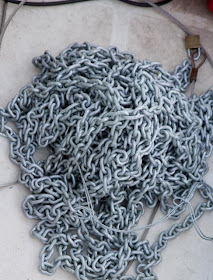 |
| rusty chain--some links are in better shape than others |
If you’re
not a boater, a rusty anchor chain probably isn’t that exciting a thing to
contemplate. But when those rusty links are the link between your boat and your
anchor (a piece of equipment that is easily one of the most important items on
a boat, or under a boat) the rust gets personal.
Chain is
expensive stuff—and in recent years, because of increased costs, the protective
zinc coating found on chain has become thinner. This means that unless you are
diligent about washing down your chain, end for end it as it shows wear, and
touch it up with a wire brush and zinc paint when the first spots of rust do
show up, before you know it you’ll have a rusty ball of chain in your anchor
locker.
Or at least
we did. Our chain is about 5 years old. Not that old in the boating world—but a
few years of constant use, followed by a year in the anchor locker meant that
our chain was rapidly approaching the cut-off point between salvageable and
garbage. Although surface rust, even if it’s a bit flakey, isn’t the end of the
world for chain-but you do need to remove heavy rust to have chain
regalvanized.
As a
guideline you should toss rusty chain if:
- Wear
exceeds 10% of a link diameter (check where the links connect).
- The chain
is cut, nicked, cracked, gouged, or pitted.
- It’s
distorted, twisted, bent or stretched.
- You don’t
know its history, including how many times it’s been regalvanized.
If you got
around to regalvanizing before we did and the surface rust was fairly light
(indicating you still have some zinc coating left) you can probably send it
straight for regalvanizing without prep. If you have more rust then you’ll need
to look at sandblasting, which is normally hugely expensive, unless you try a
version of poor mans sand blasting.
 |
| bare metal after 10 km--we were still able to see the stamps on the links indicating we hadn't lost much material |
We headed
off out of Brisbane
in search of a sandy road. When we found one we tied the chain the trailer
hitch and set off down the empty road (the one car that passed us was pretty
confused, or thought we were confused). By end-for-ending the chain a couple of
times and driving through sweeping S turns the chain started to show bright
metal after about 10k. Then it was off for galvanizing.
Because I ask
about this stuff I learned the first step of the galvanizing process is a
caustic soda solution to remove grease and oils from the steel. The chain is
then immersed into a pickling solution of sulfuric acid. Then it’s ready for
the molten zinc.
 |
| newly galvanized chain |
The result
is a thicker coating of zinc than what the chain had when it was manufactured—which
means it should last longer. Especially because we’ll take better care of it
this time round and not wait so long before regalvanizing it again.
Our cost at
Industrial Galvanizers in Brisbane
was $2.05 a kilo—and our chain came in at $166. Far less than new chain would
have cost (we can’t get our chain here so would have needed a new gypsy as
well).



Nice post! Our new chain cost us a fortune! So anything I can do to protect it, is worth it!
ReplyDeleteHey Tasha, Chain care is going to be part of our new routine too. We're hunting down zinc paint and plan to keep a much better eye on it this time.
ReplyDelete